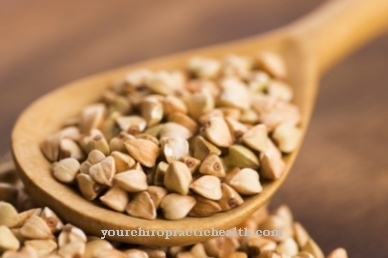Of the Castor oil is also as wondertree known. The oil from the tropical plant is primarily used as a laxative.
Occurrence and cultivation of the miracle tree

Specimens that grow in Europe, however, only reach a height between 50 centimeters and 4 meters. The palm-shaped leaves can reach a size of up to 70 centimeters. Depending on the variety of the miracle tree, they have a green, blue-gray or red color. The flowering time of the Ricinus communis is between July and October.
By late autumn, the spiky fruit capsules of the flowers produce seeds, which are shaped like beans. The Ricinus communis is native to the tropical regions of Africa and India. The plant is grown in tropical regions while it has been released into the wild in southern Europe. In the USA, the miracle tree is sometimes considered a weed.
Effect & application
The best known ingredients of the wonder tree are ricin and castor oil (Ricinum oleum). However, the ricin has a toxic effect and occurs in the seed coats of the plant. Even small amounts of ricin can be deadly. The affected people die of circulatory failure within two days.
On the other hand, castor oil has a therapeutic effect. This is obtained from the seeds of the plant by cold pressing and is not poisonous. With the help of the pressing process, the transfer of the toxic rizin to the oil can be prevented.
In medicine, castor oil is used both internally and externally. It is composed of the triglycerides of ricinoleic acid. Within the small intestine, ricinoleic acid is released by lipases. The ricinoleic acid develops the actual effect of the castor oil. It thus prevents the absorption of water and sodium from the intestines. This allows more water and electrolytes to reach the intestines, which leads to an increase in the amount of stool.
In addition, the stool becomes softer, which in turn has a laxative effect. Irritation of the intestinal mucosa by ricinoleic acid is also responsible for the laxative effect. The castor oil is administered internally in the event of constipation. It can be given in the form of a drink or as an enema (enema). Alternatively, 1 to 2 tablespoons of castor oil can be taken on an empty stomach.
The laxative effect starts after about two to four hours. However, the pure oil has a bad taste. To improve this, it can be mixed with some fruit syrup or lemon juice. Cooling the castor oil is also considered helpful. Alternatively, capsules are also available, which are tasteless and therefore much easier to take. The capsules usually contain four to six grams of castor oil. A lower dosage has a negative effect on the effectiveness of the laxative.
It is recommended not to exceed 14 days when using castor oil. Experts also advise against taking castor oil in the event of poisoning. In this way, the oil ensures that numerous poisons are spread even faster in the body. Interactions with various drugs are also possible. Castor oil can also be administered externally. In the case of skin diseases, it can be rubbed onto the affected areas several times a day.
Importance for health, treatment & prevention
The castor plant was already known in earlier times for its laxative effect. The ancient Egyptians used the seeds of the plant to empty the intestines, which often resulted in poisoning. The ancient Greeks therefore only used the miracle tree for external treatments. In China and India, the seeds were crushed and used for compresses against facial paralysis or joint swelling. Castor tea made from roots and leaves was also used to treat cough problems.
In the late 18th century, castor oil was widely used in Europe as a laxative without causing poisoning. It was also used to coat eyelashes. Today, castor oil is used more for industrial products. This includes cosmetics, lubricants, papers and paints.
Nowadays, castor oil is rarely administered therapeutically. If other measures against constipation remain ineffective, it is suitable for short-term treatment to achieve accelerated emptying of the bowel. This can be the case after a wormer or after anal-rectal surgery. Castor oil is also helpful for inflammatory skin diseases. The same goes for age spots, scars, flakes of skin, and hemorrhoids.
The oil has the property of penetrating the spaces between cells. As it also creates a mechanical protective film against water and water-soluble pollutants, it helps heal fissures and cracks. Castor oil is not recommended in late pregnancy. The oil is said to promote labor, but its mechanism of action is still not exactly known.
For this reason, use after the 40th week of pregnancy may only take place under specialist supervision. Possible side effects of taking castor oil internally are nausea and diarrhea.

















.jpg)



.jpg)

.jpg)




